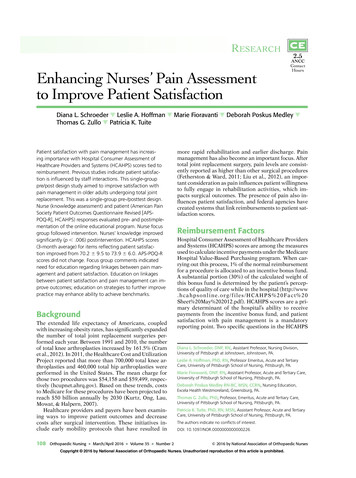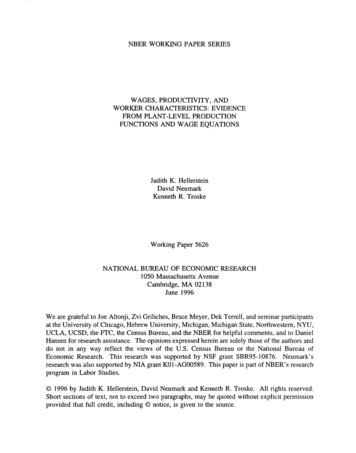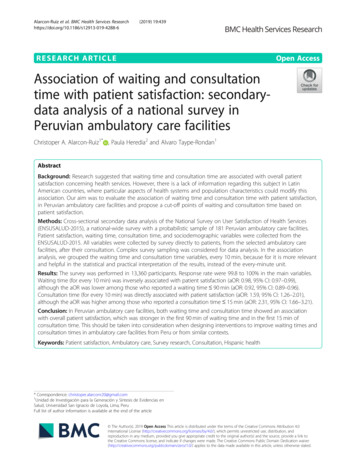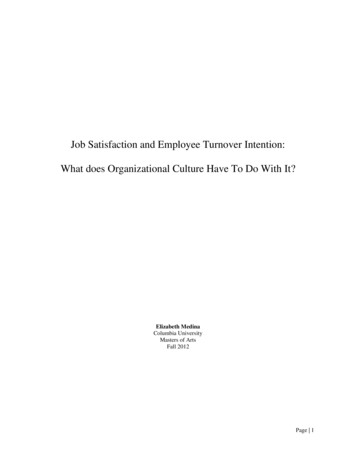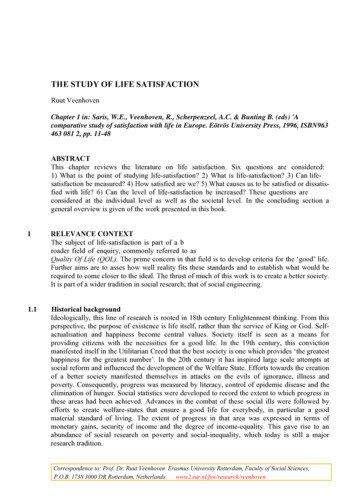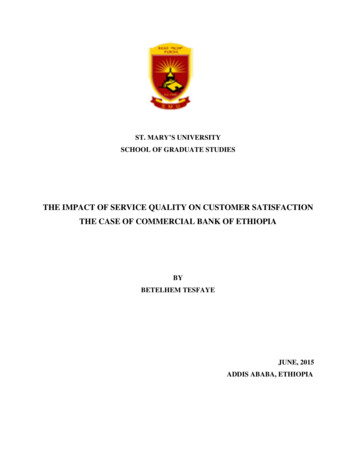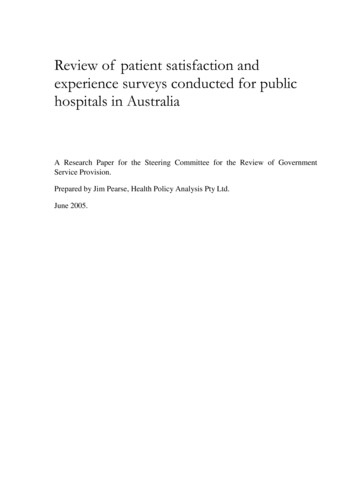
Transcription
Review of patient satisfaction andexperience surveys conducted for publichospitals in AustraliaA Research Paper for the Steering Committee for the Review of GovernmentService Provision.Prepared by Jim Pearse, Health Policy Analysis Pty Ltd.June 2005.
IIREVIEW OF PATIENTSURVEYS
ContentsCONTENTSIIIEXECUTIVE SUMMARY114Background2Research methods53International developments64Description of approaches taken in Australia and each jurisdiction105Comparison of methods236Future directions40References44Appendix AJurisdiction informants interviewedAppendix BReview of questions included in patient surveyinstrumentsAppendix CPatient survey instruments in Australian jurisdictionsAppendix DHospital CAHPS (H-CAHPS) instrument — draftAppendix EBritish NHS admitted patient instrumentAppendix FWorld Health Survey 2002 — Patient ResponsivenessSurveyREVIEW OF PATIENTSURVEYSIII
1Executive SummaryHealth Policy Analysis Pty Ltd was engaged by the Steering Committee for theReview of Government Service Provision to review patient satisfaction andresponsiveness surveys conducted in relation to public hospital services inAustralia. The review identified current patient satisfaction surveys (including any‘patient experience surveys’) of public hospital patients conducted by (or for) Stateand Territory governments in Australia that are relevant to measuring ‘publichospital quality’. The review examined surveys from all jurisdictions except theAustralian Capital Territory and the Northern Territory. Interviews were held withkey informants from each of the jurisdictions. In addition, internationaldevelopments were briefly reviewed.One objective of this project was to: identify points of commonality and difference between these patient satisfactionsurveys and their potential for concordance and/or for forming the basis of a ‘minimumnational data set’ on public hospital ‘patient satisfaction’ or ‘patient experience’.It was concluded that: All the Australian patient based surveys assess similar aspects of patientexperience and satisfaction and therefore there is some potential for harmonisingapproaches. In recent years, a similar initiative has been underway in relation to Statecomputer assisted telephone interview (CATI) population health surveys. Thishas occurred under the umbrella of the Public Health Outcomes Agreement.However, there is no similar forum for addressing patient surveys. As a result,communications between jurisdictions have been largely ad hoc. A starting pointfor this process would be to identify an auspicing body and create a forumthrough which jurisdictions can exchange ideas and develop joint approaches. With respect to patient experience, population surveys (such as the NSW survey)have some fundamental differences to patient surveys and therefore pursuingharmonisation between these two types surveys is unlikely to result in usefuloutcomes. The major focus should be on exploring the potential to harmonise thesurveys that are explicitly focused on former patients. The different methodologies adopted for the patient surveys pose significantimpediments to achieving comparable information. One strategy for addressingREVIEW OF PATIENTSURVEYS1
some of these problems is to include in any ‘national minimum data set’ a rangeof demographic and contextual items that will allow risk adjustment of results.However, other differences in survey methodologies will mean basic questionsabout the comparability of survey results will persist.Another objective of this project was to ‘identify data items in these surveys thatcould be used to report on an indicator of public hospital quality, in chapter 9 of theannual Report on Government Services. This indicator would be reported on a noncomparable basis initially but, ideally, have potential to improve comparability overtime.’ Whilst the issues of differences in methods make comparison very difficult,there are several areas in which some form of national reporting could occur,initially on a non-comparative basis. Most of the surveys include overall ratings of care, and these have been reportedin previous editions of the Report on Government Services. With some degree ofcooperation there is some potential to standardise particular questions related tooverall ratings of care, and related to specific aspects of care. The patient based surveys adopt a variety of approaches to eliciting overallratings of care. Whilst there are some doubts over the value of overall ratings,there appear to be good opportunities to adopt an Australian standard questionand set of responses. In addition, supplementary questions related to overallaspects of care could be agreed to including: patient’s views on the extent to andhow the hospital episode helped the patient, and also judgments about theappropriateness of the length of hospital stay. Comparative information will be more useful if there is the potential to explorespecific dimensions of care. Table 5.8 sets out a number of areas in which noncomparative data could be reported in the short term with a medium term agendaof achieving standard questions and responses. These address the followingaspects of patient experiences.– Waiting times — The issue is not actual waiting times but patients’assessment of how problematic those waiting times were. The experience ofhaving admissions dates changed could also be assessed.– Admission processes — Waiting to be taken to a room/ward/bed — againthe issue is not actual waiting times but patient assessment of howproblematic that waiting was.– Information/Communication — Focusing on patient assessments of theadequacy of information provided about the condition or treatment, and theextent to which patients believed they had opportunities to ask questions.– Involvement in decision making — Focusing on patient assessments of theadequacy of their involvement in decision making.2REVIEW OF PATIENTSURVEYS
– Treated with respect — Patients’ views on whether hospital staff treatedthem with courtesy, respect, politeness and/or consideration. These questionscould be split to focus specifically on doctors versus nurses. Patientassessments of the extent to which cultural and religious needs wererespected could also be included.– Privacy — Patient assessments on the extent to which privacy was respected.– Responsiveness of staff — Most surveys include a patient experiencequestion related to how long nurses took to respond to a call button. Relatedquestions concerning availability of doctors is included in several surveys.– Management of pain– Information provided related to new medicines– Physical environment — Patient assessments of cleanliness of rooms andtoilets/bathrooms, quietness/restfulness, quality, temperature and quantity offood.– Management of complaints — Patient assessments of how complaints werehandled.– Discharge — Information provided at discharge on to how to manage thepatient’s condition.The major challenge here is that many of the surveys adopt different sets ofstandard responses for rating these and other questions.In addition to jurisdictional surveys, the project examined two internationalexamples of surveys of hospital patients that could provide suitable templates for anational minimum dataset on public hospital ‘patient satisfaction’ or ‘patientexperience’ — the UK National Health Service (NHS) survey (for admittedpatients) and the US based H-CAPHS. The main advantage of adopting or adaptingone of these approaches is that they are supported by significant investment andrigorous attention to methods. A secondary advantage is the potential forinternational comparison. Whilst the experience with these international surveys haslessons for Australia, and may well inform the future development of Australianbased instruments, the Australian based surveys — particularly the Victorian PatientSatisfaction Monitor (VPSM) and the WA surveys — also have relatively strongmethodological bases and strong jurisdictional commitment. Wholesale adoption ofinternational instruments is unlikely to be acceptable to these jurisdictions.REVIEW OF PATIENTSURVEYS3
1BackgroundHealth Policy Analysis Pty Ltd was engaged by the Steering Committee for theReview of Government Service Provision to identify and evaluate patientsatisfaction and responsiveness surveys conducted in relation to public hospitals inAustralia. This project had several objectives, including to: identify all current patient satisfaction surveys (including any ‘patient experiencesurveys’) conducted in relation to public hospital patients by (or for) State andTerritory governments in Australia that are relevant to measuring ‘publichospital quality’ identify points of commonality and difference between these patient satisfactionsurveys and their potential for concordance and/or for forming the basis of a‘minimum national data set’ on public hospital ‘patient satisfaction’ or ‘patientexperience’ identify data items in these surveys that could be used to report on an indicatorof public hospital quality, in Chapter 9 of the annual Report on GovernmentServices. This indicator would be reported on a non-comparable basis initiallybut, ideally, have potential to improve comparability over time identify international examples of surveys of public hospital patients that couldprovide suitable models for a national minimum dataset on public hospital‘patient satisfaction’ or ‘patient experience’.The project was researched through examination of publicly available material fromeach state and territory, interviews with key informants from each jurisdiction and abrief review of international literature.This paper is structured as follows. Chapter 2 describes the methods adopted for thisproject. Chapter 3 briefly reviews selected international developments related tosurveys of patient experience. Chapter 4 describes the approach taken in eachjurisdiction to surveying and tracking patient satisfaction and experience. Chapter 5reviews and compares methods adopted in each jurisdiction. Chapter 6 considerspotential future directions and makes a number of recommendations forconsideration by the Health Working Group and the Steering Committee.Appendix A lists the people interviewed in each jurisdiction for this project.Appendix B provides a comparison of each of the survey instruments reviewed,whilst the survey instruments are presented in Appendix C. International surveyinstruments are presented in Appendices D, E and F (see separate pdf. files).4REVIEW OF PATIENTSURVEYS
2Research MethodsTo assist this research project, a targeted review of the literature was undertaken,focusing mainly on recent developments in the area of assessment ofresponsiveness, patient satisfaction and experience. The literature review includedan examination of Draper and Hill (1995), which examined the potential role ofpatient satisfaction surveys in hospital quality management in Australia.Since Draper and Hill, there have been several major national and internationaldevelopments. In particular, five Australian States have invested in developingongoing programs for surveying patient satisfaction and experience. Internationally,the British National Health Service (NHS) has adopted a national approach tosurveying patient experience. More recently, the United States’ centres forMedicare and Medicaid have announced that all US hospitals participating in theMedicare Program (which is effectively all US hospitals) will be surveyed using astandardised instrument — Hospital-Consumer Assessment of Health Plans Survey(HCAHPS). Leading to and following the World Health Report 2000, the WorldHealth Organisation (WHO) has also sponsored significant work on thedevelopment of methods of assessing health system responsiveness (see, forexample, Valetine, de Silva, Kawabata et al. 2003; Valetine, Lavellee, Liu et al.2003). Major reports relating to these developments were examined for this paper(see chapter 3).Key informants from all Australian States and Territories were contacted andinterviewed by telephone (see appendix A). Copies of States’ surveys wererequested and these were supplied for each survey examined (see appendix C).During these interviews, the informants were asked questions about: current approaches to surveying patient satisfaction and experience in theirjurisdiction nature of the surveys conducted, including the years in which surveys have beenconducted details of sample sizes, selection criteria and processes, and demographicspecifications survey methods timing of the survey relative to hospital admission the specific questions in the survey related to hospital quality/satisfaction how results are fed back to hospitals whether and how results are made available to the broader public.REVIEW OF PATIENTSURVEYS5
3International DevelopmentsThe extensive literature on methodologies for assessing patient satisfaction reflectseveral competing orientations including market research approaches,epidemiological approaches and health services research. Patient satisfactionemerged as an issue of interest for health service researchers and healthorganisations in the 1970s and 1980s. In recent decades a number of organisationshave emerged, particularly in the United States and Europe, that developedexpertise and markets in managing patient surveys, and analysing andbenchmarking results (for example, Picker and Press Ganey). These organisationsdominate this market, although many health care organisations and individualsimplement an enormous variety of patients surveys.Draper and Hill (1995) reviewed and described projects and initiatives that had beenundertaken in Australia up to the mid-1990s. At that point in time, three AustralianStates (NSW, Victoria and Western Australia) had been relatively active indeveloping and conducting statewide surveys. Since that time, NSW has abandoneda specific patient survey, although Queensland, South Australia and Tasmania haveimplemented patient survey approaches.Whilst statewide approaches have not been implemented in all States andTerritories, patient surveys are conducted in some form in public hospitals in allStates and Territories. One of the motivations for these patient surveys relates to theaccreditation process implemented by the Australian Council on HealthcareStandards (ACHS). The ACHS’ EQuIP process requires all accredited hospitals(public and private) to undertake patient experience and satisfaction surveys.Initially, these patient satisfaction surveys typically asked patients to rate theirsatisfaction with various aspects of hospital services. In the 1990s, patientsatisfaction surveys became quite common, but were often been criticised on thebasis of conceptual problems and methodological weaknesses (see, for example,Hall and Dornan 1988; Aharony and Strasser 1993; Carr-Hill 1992; Williams 1994;Draper and Hill 1995; Sitzia and Wood 1997). Several conceptual andmethodological issues were identified. Satisfaction is a multi-dimensional construct. There is limited agreement onwhat are the dimensions of satisfaction, and a poor understanding of whatoverall ratings actually mean. Surveys typically report high levels of overall satisfaction (rates that are similaracross a broad range of industries), but often there is some disparity between theoverall satisfaction ratings, and the same patients’ opinions of specific aspects oftheir care process (Draper and Hill 1995).6REVIEW OF PATIENTSURVEYS
Survey approaches have often reflected the concerns of administrators andclinicians rather than reflecting what is most important to patients. Satisfaction ratings are affected by: the personal preferences of the patient; thepatient’s expectations; and the care received. Systematic biases have been noted in survey results — for example, olderpatients are generally more satisfied with their hospital experience than youngerpatients; patients with lower socio-economic circumstances are generally moresatisfied than wealthier patients.One response to these criticisms has been the development of survey approachesthat assess actual patient experiences. It is argued that this enables a more direct linkto actions required to improve quality (see, for example, Cleary 1993). This is oneof the underlying philosophies of the Picker organisation. A qualitative researchprogram involving researchers at Harvard Medical School was implemented toidentify what patients value about their experience of receiving health care and whatthey considered unacceptable. Various survey instruments were then designed tocapture patients’ reports about concrete aspects of their experience. The programidentified eight dimensions of patient-centred care: Access (including time spent waiting for admission or time between admissionand allocation to a bed in a ward) Respect for patients’ values, preferences and expressed needs (includingimpact of illness and treatment on quality of life, involvement in decisionmaking, dignity, needs and autonomy) Coordination and integration of care (including clinical care, ancillary andsupport services, and ‘front-line’ care) Information, communication and education (including clinical status,progress and prognosis, processes of care, facilitation of autonomy, self-care andhealth promotion) Physical comfort (including pain management, help with activities of dailyliving, surroundings and hospital environment) Emotional support and alleviation of fear and anxiety (including clinicalstatus, treatment and prognosis, impact of illness on self and family, financialimpact of illness) Involvement of family and friends (including social and emotional support,involvement in decision making, support for care giving, impact on familydynamics and functioning)REVIEW OF PATIENTSURVEYS7
Transition and continuity (including information about medication and dangersignals to look out for after leaving hospital, coordination and dischargeplanning, clinical, social, physical and financial support).The Picker approach (based on these eight dimensions) has subsequently formed thebasis of the United Kingdom’s NHS patient survey and was adapted for somesurveys in Australia in previous years.Since 1998, the United Kingdom’s NHS has mandated a range of surveys includingsurveys of acute inpatients. National survey instruments have been developed withthe Picker Institute in Europe. Whilst the surveys are centrally developed andaccompanied by detailed guidance, they are generally implemented locally byindividual healthcare organisations. Results from previous surveys are publishedand form part of the rating systems using for assessing health service performanceacross England. For this project the latest survey instrument for acute inpatients wasanalysed (see appendix E).Another important international initiative (yet to be finalised) is the development ofthe Hospital-Consumer Assessment of Health Plans Survey (H-CAHPS) in theUnited States. The Consumer Assessment of Health Plans (CAHPS) was originallydeveloped for assessing health insurance plans. The development occurred underthe auspices of the US Agency for Healthcare Research and Quality (AHRQ),which has provided considerable resources to ensure a scientifically basedinstrument. The work on CAHPS was originally published in 1995 along withdesign principles that would guide the process of survey design and development.CAHPS instruments go through iterative rounds of cognitive testing, rigorous fieldtesting, and process and outcome evaluations in the settings where they would beused. Instruments are revised after each round of testing (see Medical CareSupplement, March 1999, 37(3), which is devoted to CAHPS). Various CAHPSinstruments were subsequently adopted widely across the US.The H-CAHPS initiative has occurred as a result of a request from the Centres forMedicare and Medicaid for a hospital patient survey which can yield comparativeinformation for consumers who need to select a hospital and as a way ofencouraging accountability of hospitals for the care they provide.Whilst the main purposes of H-CAHPS are consumer choice and hospitalaccountability, AHRQ states that the instrument could also provide a foundation forquality improvement. The H-CAHPS survey will capture reports and ratings ofpatients’ hospital experience. AHRQ has indicated that as indicated in the literature, patient satisfaction surveys continually yield highsatisfaction rates that tend to provide little information in the way of comparisonsbetween hospitals. Patient experiences tend to uncover patient concerns about their8REVIEW OF PATIENTSURVEYS
hospital stay, which can be of value to the hospitals (in quality improvement efforts) aswell as consumers (for hospital selection).For this paper, a draft version of the H-CAHPS instrument (see appendix D) hasbeen compared with the various Australian survey instruments.In the World Health Report 2000, the WHO presented a framework for assessinghealth system performance. The framework identified health system responsivenessas an important component of health system performance. Responsiveness isconceptualised as the way in which individuals are treated and the environmentwithin which they are treated (Valetine, de Silva, Kawabata et al. 2003). The WHOidentified eight dimensions of responsiveness: respect for autonomy choice of care provider respect for confidentiality communication respect for dignity access to prompt attention quality of basic amenities and access to family and community support.Following criticism of the approach taken to assessing responsiveness for the WorldHealth Report 2000, the WHO sponsored a work program to develop surveymethods for assessing responsiveness. These were trialled in a multi-country surveyconducted in 2000-01 and subsequently in the World Health Survey 2002 (Valetine,Lavellee, Liu et al. 2003). Questions from the 2002 survey are provided inappendix F.REVIEW OF PATIENTSURVEYS9
4Description of approaches taken in Australia andeach jurisdictionNationalTQA conducts the ‘Health Care & Insurance — Australia’ survey, a biennial surveyof the public which elicits views on a broad range of health related issues. Thesurvey is supported and/or purchased by Australian, State and Territory governmenthealth departments, private health insurance organisations, hospital operators andhealth related industry associations.The TQA survey is conducted by computer-assisted telephone interview (CATI). Itsurveys randomly selected households/insurable units. Interviews are conductedwith the person in the unit identified as the primary health decision maker. The mostrecent survey, conducted from 12 July to 12 August 2003, had 5271 respondentsfrom all States and Territories. Numbers ranged from 1434 interviews in NSW to350 interviews in the ACT. Response rates were not available.The actual survey instrument was not analysed for this paper, although the questionscan be interpreted from the results of the survey. The survey canvases views of thepublic generally (including those who have not used health services) andrespondents who have been patients. Respondents are asked to rate overall healthcare including: Medicare; the services offered by public hospitals; the serviceoffered by private hospitals; GPs and the services they offer; specialist doctors; andState and Territory health departments. The response choices are Very High, FairlyHigh, Neither High nor Low, Fairly Low, Very Low. The percentage of respondentsgiving ‘very high’ and/or ‘fairly high’ responses are published for some of thesemeasures. Responses are also given a numeric value (with Very High 100 andVery Low 0) and mean ratings are then calculated and published. Table 1 showsthe results of general public ratings of public hospitals by jurisdictions from theTQA surveys since 1987.Patients (respondents who have attended a hospital) are asked to identify howsatisfied they were with their hospital stay, with responses of ‘very satisfied’ to ‘notat all satisfied’. The sample size for patients is not reported, but it is likely to besmall — around 700 across Australia. The percentage of respondents giving veryhigh’ and/or ‘fairly high’ responses were published for public and private hospitals(see table 2), together with mean ratings of public hospital stays by jurisdiction forthe 2003 survey (see table 3).10REVIEW OF PATIENTSURVEYS
Table 1Patients who rate the service of public hospitals ‘very high’ or‘fairly high’ (per 52514451452003424346614951514646Source: TQA.Table 2Patients who were ‘very satisfied’ with their last hospital visit(per cent)YearPublic HospitalsPrivate ource: TQA.Table 3Mean satisfaction scores — public hospital stayScale: ‘very satisfied’ 100 ‘not at all satisfied’ 82Source: TQA.Patients who were dissatisfied with their stay are asked to say why. The 10 per centof patients who were dissatisfied with their public hospital visit in the 2003 surveysaid this was because of (in order): Uncaring/rude/lazy staff (36 per cent of dissatisfied patients) Waiting for place in hospital/waiting for admission (21 per cent) Lack of staff (17 per cent) Poor information/communication (15 per cent) Personal opinion not listened to/not able to discuss matters (9 per cent).REVIEW OF PATIENTSURVEYS11
New South WalesNew South Wales reports on patient satisfaction based on analysis of questionsincluded in the NSW Continuous Health Survey, which was a computer-assistedtelephone interview (CATI) survey conducted on a random sample of the NSWpopulation. The current continuous survey commenced in 2002, but previoussurveys included adult health surveys in 1997 and 1998, an older people’s healthsurvey in 1999, and a child health survey in 2001. The survey is managed andadministered by the Centre for Epidemiology and Research in the NSW HealthDepartment, although it is conducted in collaboration with the NSW area healthservices. Since the commencement of the continuous survey, reports have beenpublished for 2002 and 2003.The main objectives for the NSW surveys are to provide detailed information on thehealth of the people of NSW, and to support the planning, implementation, andevaluation of health services and programs in NSW. Estimation of patientsatisfaction levels forms a component of the evaluation of health services, but it isnot a principal focus of the survey. The survey instrument covers eight priorityareas. It included questions on: social determinants of health including demographics and social capital environmental determinants of health including environmental tobacco smoke,injury prevention, and environmental risk individual or behavioural determinants of health including physical activity,body mass index, nutrition, smoking, alcohol consumption, immunisation, andhealth status major health problems including asthma, diabetes, oral health, injury and mentalhealth population groups with special needs including older people and rural residents settings including access to, use of, and satisfaction with health services; andhealth priorities within specific area health services partnerships and infrastructure including evaluation of campaigns and policies.The target population for the survey in 2003 was all NSW residents living inhouseholds with private telephones. The target sample comprised approximately1000 people in each of the 17 Area Health Services (total sample of 17 000). Intotal, 15 837 interviews were conducted in 2003, with at least 837 interviews ineach Area Health Service and 13 088 with people aged 16 years or over. The overallresponse rate was 67.9 per cent (completed interviews divided by completedinterviews and refusals).12REVIEW OF PATIENTSURVEYS
In relation to hospital services, the survey asked whether the respondent stayed atleast one night in a hospital in the last 12 months. NSW Health reports that 2012respondents identified that they had been admitted (overnight) to hospital in theprevious 12 months, equivalent to estimated 13.5 per cent of the overall population.The name of the hospital was identified, along with whether the hospital was apublic or private hospital, and whether the admission was as a private or publicpatient. Respondents were then asked ‘Overall, what do you think of the care youreceived at this hospital?’ Response choices were: Excellent; Very Good; Good;Fair; Poor; Don’t Know; and Refused. Respondents who rated their care Fair orPoor were then asked to describe why they rated the care fair or poor, with an openended question. Respondents were also asked ‘Did someone at this hospital tell youhow to cope with your condition when you returned home?’ and ‘How adequatewas this information once you went home?’A similar set of questions was asked of respondents who had used communityhealth services and public dental services. For respondents who had usedemergency departments, a similar overall rating question was asked, along with anopen ended question if they rated their care as fair or poor.Respondents were asked ‘Do you have any difficulties getting health care when youneed it?’, and were given an opportunity to provide open ended responsesdescribing their difficulties. Respondents were also given the opportunity to offerany comments on health services in their local area.The NSW survey included questions relating to demographics, geographic locationand socio-economic status, so the relationships between a person’s rating of careand some these characteristics can be examined. Several analyses are reported bythe NSW health department, but confidence intervals are very wide and statisticalevidence of differences is weak. For example, estimated ratings are significantlydifferent from the statewide
responsiveness, patient satisfaction and experience. The literature review included an examination of Draper and Hill (1995), which examined the potential role of patient satisfaction surveys in hospital quality management in Australia. Since Draper and Hill, there have been several major national and international developments.
